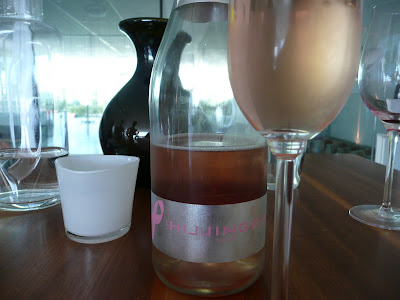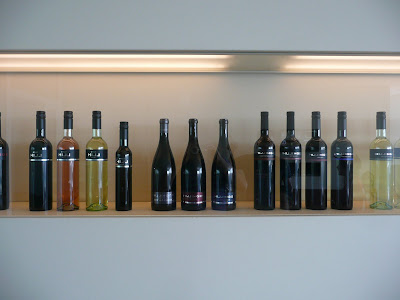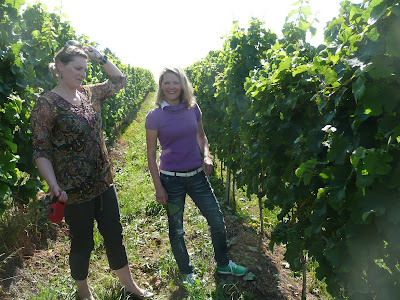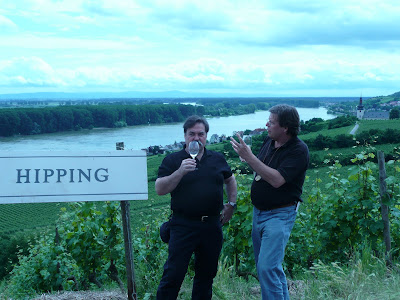
 Pictures: Christian G.E. Schiller with Leo Hillinger, Michael Hoeffken and Edgar Brutler at the Leo Hillinger Winery in Jois, Austria
Pictures: Christian G.E. Schiller with Leo Hillinger, Michael Hoeffken and Edgar Brutler at the Leo Hillinger Winery in Jois, AustriaThe wines of Leo Hillinger from Austria are known all over the world. The main public face of Weingut Leo Hillinger for consumers in the US and Asia, along with Leo Hillinger of course, is Michael Hoeffken, Sommelier, Assistant Winemaker and Sales Person at Weingut Leo Hillinger.
I was in Austria this summer, including in Hofturn in Burgenland, by car just 30 minutes away from Jois, where Weingut Leo Hillinger is located. When Michael heart about this, he invited me over and we spent a couple of hours together at the winery. We were joined by Edgar Brutler, the winemaker and also by Leo Hillinger.

 Pictures: Christian G.E. Schiller with Michael Hoeffken and US Importer Klaus Wittauer in Washington DC and with Michael Hoeffken in Vienna, Austria
Pictures: Christian G.E. Schiller with Michael Hoeffken and US Importer Klaus Wittauer in Washington DC and with Michael Hoeffken in Vienna, AustriaI had met Michael Hoeffken the first time in Vienna, Austria and then later in Washington DC, where we tasted some Leo Hillinger red wines.
Weingut Leo Hillinger in Burgenland
Weingut Leo Hillinger is in Jois in the Neusiedlersee area in Burgenland. Burgenland is one of Austria’s 4 wine regions – Lower Austria, Styria, Burgenland and Vienna. For many years it was a bit on the margin, although it has a long wine growing tradition. Burgenland belonged to Hungary until 1921 when it was annexed to Austria post WWI. It is a melting pot of Magyar, Slavic and Austrian cultures. Many of the towns have two names, one Croatian or Hungarian and the other name Austrian. The vineyard area of Burgenland totals 14.000 hectares and comprises 4 areas: (1) Neusiedlersee: At the edges of the vast and shallow Lake Neusiedl, a variety of grapes are grown on 9.100 hectares of vineyards, including world-famous noble sweet wines. (2) Neusiedlersee-Hügelland: At the foot of the Leithagebirge and west of Lake Neusiedl, a variety of grapes are grown on 4.150 hectares of vineyards, including the renowned Ruster Ausbruch. (3) Mittelburgenland: On 2.100 hectares of vineyards, one red grape variety plays the leading role: Blaufränkisch and 4 towns are the wine-growing area´s main producers: Deutschkreutz, Horitschon, Lutzmannsburg and Neckenmarkt. (4) Südburgenland: One of Austria´s smallest wine-growing areas, where excellent terroir wines are produced from 500 hectares of vineyards, which are situated mainly on the Eisenberg, with Blaufraenkisch being the typical red wine.
 Picture: The Wine Regions of Austria
Picture: The Wine Regions of AustriaLeo Hillinger took over from his father in 1990. At the time, the Weingut was tiny with only one hectare of vineyard area. Under Leo’s stewardship the winery has seen a phenomenal growth. Today, the vineyard area totals 46 hectares, of which 26 hectares are in Jois in the Neusiedlersee region, and another 20 hectares in and around Rust in Neusiedlersee-Huegellland. 60% of the area is planted with red varieties - Blaufränkisch, Zweigelt, St. Laurent, Pinot Noir, Cabernet Sauvignon, Merlot and Syrah - and the remaining 40% are planted with the white varieties - Welschriesling, Sauvignon Blanc and Chardonnay. In addition, grapes are sourced from contract growers with another 70 hectares of vineyards. Weingut Leo Hillinger is one of the top names in Austria. It ranks among Austria's largest producers of premium wines. More than 50% of the production is exported.
The Winery in Jois
The winery in Jois is an impressive super-modern building in the middle of the vineyards. Michael explained that the new production site with an associated tasting and seminar center was constructed in 2004 for 6 million Euros. The sensitive location in the midst of the Jois vineyards required special attention.
The major part of the L-shaped production building was cut deeply into the slope, subsequently covered with soil and as far as possible replanted with grapes; 24.000 cubic meters of soil had to be moved and re-moved during the course of construction.

 Pictures: Leo Hillinger Winery in Jois, Austria
Pictures: Leo Hillinger Winery in Jois, AustriaThe visible part with the cubic tasting lounge seems to hover upon slim V-shaped pillars over the ground. The large window opens to the vineyards and the Leithagebirge mountain range; at night it presents a recognizable landmark beacon that can be seen from far away.
Eight northern-facing, pyramidal roof windows allow for natural light to illuminate the subterranean production hall, which ranks among the most modern in Europe. The newly planted accessible roof terrace offers wonderful views of Lake Neusiedl.
Tasting in the Cellar with Michael Hoeffken and Edgar Brutler
Michael and Edgar took me to the cellar and showed me around. We did some barrel tasting there.



 Pictures: Christian G.E. Schiller Tasting in the Cellar with Michael Hoeffken and Edgar Brutler
Pictures: Christian G.E. Schiller Tasting in the Cellar with Michael Hoeffken and Edgar BrutlerEdgar explained that the cellar technique equipment ranks among the most modern in Europe. The computerized cellar secures hygienic and safe production measures which meet highest quality standards. Fermentation of the selected grape material takes place in computer-controlled stainless steel tanks. These fermentation vessels used in the Hillinger winery are jacketed tanks allowing cool fermentation and maturation of the wine due to refrigerating coils between the two walls – a fact which plays an important role in white wine production. Furthermore the stainless steel tanks guarantee a production according to highest hygienic guide lines as well as a controlled fermentation due to exact temperature regulation. Especially fresh fruity wines like Welschriesling, Riesling, Sauvignon Blanc and light red wines are vinificated in stainless steel tanks.
The barrique-barrels of the Hillinger Winery are exclusively made of French oak. With regard to white wine, barrique barrels are predominantly used for fermentation while with red wines only maturation takes place in barriques. Typically, the barriques are only used twice at Weingut Leo Hillinger.
In the Vineyards of Jois
After the cellar tasting we went outside to see a bit of the vineyards that are in Jois. We had a wonderful view of Lake Neusiedl.
Above all, Michael said, the warm and sunny climate in Burgenland is decisive for the wine quality. The near Lake Neusiedl accounts for rising temperatures in summer which lead to higher sugar gradations and full-bodied wines. The soils on which the grapes ripen are an additional criterion. They decisively influence the character of the wines. The light, dry loess and black earth soils are responsible for powerful compact wines.
With regard to vineyard management, Weingut Leo Hillinger favors integrated plant protection, green manure and biological fertilization of the vines. Fertilization measures are applied with an eye on biological balance while organic fertilizers are used only in a supportive manner.
Traditional harvesting as practiced at the Hillinger Winery, Michael said, signifies picking grapes by hand. Harvesters and contractual vintners pick the grapes into small boxes and deliver them directly to the production site of our winery where the cellar master conducts a final quality control.


 Pictures: Christian G.E. Schiller Tasting in the Vineyards of Jois with Michael Hoeffken and Edgar Brutler, with Lake Neusiedl
Pictures: Christian G.E. Schiller Tasting in the Vineyards of Jois with Michael Hoeffken and Edgar Brutler, with Lake NeusiedlIn the Tasting Room
We finished up in the tasting room and the conference center. Leo Hillinger joined us there.
The large window opens to the vineyards and the Leithagebirge mountain range.

 Pictures: In the Tasting Room
Pictures: In the Tasting RoomInside, glass walls grant visitors insight into the various working spheres of the wine-grower. A bridge allows a view into the barrique cellar below while linking the tasting lounge to the multi-functional seminar room behind. The entire floor space of the object comprises 1850 square meter.
 Picture: Edgar Brutler and Michael Hoeffken in the Seminar Room
Picture: Edgar Brutler and Michael Hoeffken in the Seminar Room“When the grape is excellent, then one has much less to do in the cellar. From years of experience and much-experimenting, I know that the fruit needs to be perfect and bottled without alteration.” Leo said and he continued: “I do not want an interchangeable fashionable wine, rather I want to produce a truly Austrian, if not Burgenlandian top-quality wine.”

 Pictures: Christian G.E. Schiller with Leo Hillinger and Edgar Brutler in the Tasting Room
Pictures: Christian G.E. Schiller with Leo Hillinger and Edgar Brutler in the Tasting RoomLeo finished by saying: “Making wine is for me a source of happiness. It combines hobby with vocation. I cannot imagine anything more beautiful.”
 Picture: The Wines of Leo Hillinger
Picture: The Wines of Leo Hillingerschiller-wine: Related Postings
In the Glass: 2007 Leo Hillinger HillSide Unfiltered With Weingut Hillinger's Michael Hoeffken
Picking and Drinking Gruener Veltliner with Ewald Gruber sen. and jun., Weingut Gruber, Weinviertel, Austria
Welcome to America: Franz and Christine Netzl Estate, Carnuntum, Austria
The 2010 European Wine Bloggers Conference (EWBC) in Vienna
Wine Producer Austria - Not Only Gruener Veltliner
Willi Klinger Leads Tasting of Austria's Undiscovered Stars at EWBC 2010 in Vienna
Lunch with Silvia Prieler, Weingut Prieler, Schuetzen am Gebirge, Austria
Chef Martin Weiler Suggests Amazing Food to Go With Gruener Veltliner
Austria’s Best Wines and Winemakers - Falstaff WeinGuide 2010
Producing Wines in Austria and Hungary - Franz and Franz Reinhard Weninger
Austria’s Best Red Wines - Falstaff RotweinGuide 2010/2011
With the WienWein Winemakers in Vienna in the Heurigen Drinking Gemischter Satz Wine
Wine and Food from Burgenland at Wachter-Wieslers Ratschen, Deutsch-Schuetzen, Austria - with Tom and Christoph Wachter and Julia Sevenich
Internet Guru and Medical Doctor go Wine: Weingut StephanO in Suedburgenland
German and Austrian Wines in the Wine Spectator Top 100 2010
Schiller’s Favorite Spots to Drink Wine in Vienna, Austria
Vis-a-Vis Wine Bar in Vienna, Austria
Tasting Leo Hillinger Red Wines with Leo Hillinger’s Assistant Winemaker Michael Hoeffken and US Importer Klaus Wittauer
Visit: Gerhard Wohlmuth sen. and his Weingut Wohlmuth in Austria
































